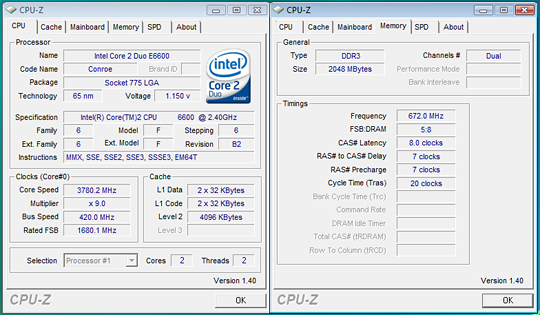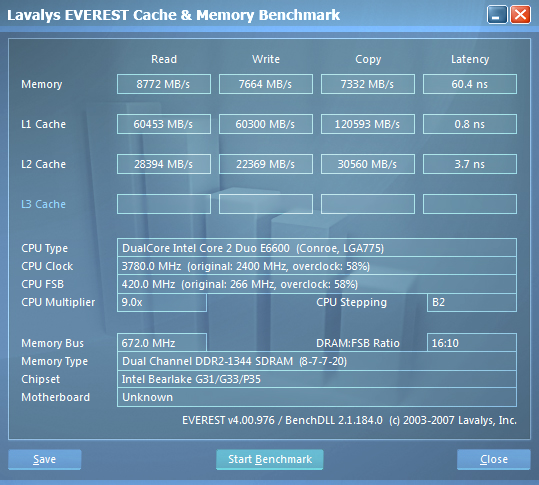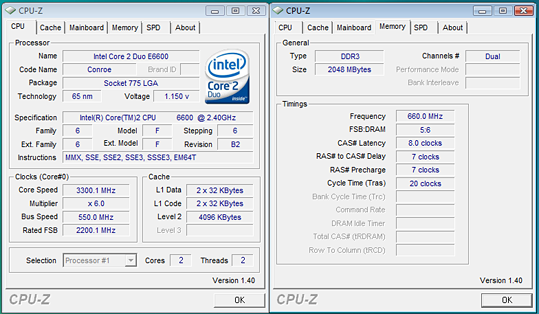Gigabyte GA-P35T-DQ6: DDR3 comes a knocking, again
by Gary Key on May 30, 2007 2:00 AM EST- Posted in
- Motherboards
E6600 Dual Core Overclocking


We were easily able to reach a final benchmark stable setting of 9x420 FSB resulting in a clock speed of 3780MHz. We were able to run our Corsair DDR3 CM3X1024-1333C9DHX at timings of 8-7-7-20 with a minimal increase in voltage to 1.55V with 4GB or 2GB of memory. We did encounter one problem and that was trying to run our memory past 1400MHz while the FSB was above 400 with the E6600. The board would boot and enter Vista up to 1600MHz but we could not complete our entire test suite unless we kept the memory below 1400MHz. We attribute this to an early BIOS design that favors tighter memory timings and latencies over high memory overclocks. Vdroop was very acceptable on this board during overclocking with an average drop of .02 ~.03V during load testing with our E6300, E6600, and X6800 CPUs.


We dropped the multiplier on our E6600 to six and were able to reach 550 FSB without an issue on the F2N BIOS. We were not able to enter Vista at 6x551 up to 6x600 although the board would POST. We managed to eke out a 6x592 result on the DDR2 version of this board so we attribute the seemingly hard lock at 550FSB to the BIOS at this time. The issue at this time with the high FSB settings is that latencies and access times suffer at the expense of memory bandwidth.
We are still working on finding the best memory multipliers and timings to utilize along with exact chipset strap changes. They tend to float between BIOS releases but we will provide a full range of results and settings in a future article. Gigabyte still has some fine tuning left to complete but overall the BIOS is in really good shape from both a performance and stability standpoint. Once the board is dialed in, stability is absolutely superb.
| Gigabyte P35T-DQ6 Dual Core Overclocking Testbed |
|
| Processor: | Intel Core 2 Duo E6600 Dual Core, 2.4GHz, 4MB Unified Cache 1066FSB, 9x Multiplier |
| CPU Voltage: | 1.4875V / 1.4500 (default 1.3250V) |
| Cooling: | Tuniq 120 Air Cooling |
| Power Supply: | OCZ ProXStream 1000W |
| Memory: | Corsair DDR3 CM3X1024-1333C9DHX (2x1GB, 4x1GB) 8-7-7-20 |
| Video Cards: | 1 x MSI HD 2900XT |
| Hard Drive: | Western Digital 150GB 10,000RPM SATA 16MB Buffer |
| Case: | Cooler Master CM Stacker 830 |
| Maximum CPU OC: | 420x9 (8-7-7-20, 1344MHz, 1.55V), CPU 1.4875V 3780MHz (+58%) |
| Maximum FSB OC: | 550x6 (8-7-7-20, 1320MHz, 1.55V), CPU 1.4500V 3300MHz (+107% FSB) |
| . | |


We were easily able to reach a final benchmark stable setting of 9x420 FSB resulting in a clock speed of 3780MHz. We were able to run our Corsair DDR3 CM3X1024-1333C9DHX at timings of 8-7-7-20 with a minimal increase in voltage to 1.55V with 4GB or 2GB of memory. We did encounter one problem and that was trying to run our memory past 1400MHz while the FSB was above 400 with the E6600. The board would boot and enter Vista up to 1600MHz but we could not complete our entire test suite unless we kept the memory below 1400MHz. We attribute this to an early BIOS design that favors tighter memory timings and latencies over high memory overclocks. Vdroop was very acceptable on this board during overclocking with an average drop of .02 ~.03V during load testing with our E6300, E6600, and X6800 CPUs.


We dropped the multiplier on our E6600 to six and were able to reach 550 FSB without an issue on the F2N BIOS. We were not able to enter Vista at 6x551 up to 6x600 although the board would POST. We managed to eke out a 6x592 result on the DDR2 version of this board so we attribute the seemingly hard lock at 550FSB to the BIOS at this time. The issue at this time with the high FSB settings is that latencies and access times suffer at the expense of memory bandwidth.
We are still working on finding the best memory multipliers and timings to utilize along with exact chipset strap changes. They tend to float between BIOS releases but we will provide a full range of results and settings in a future article. Gigabyte still has some fine tuning left to complete but overall the BIOS is in really good shape from both a performance and stability standpoint. Once the board is dialed in, stability is absolutely superb.










22 Comments
View All Comments
SirJoe - Saturday, June 2, 2007 - link
this is cool for you computer buffsGooger - Saturday, June 2, 2007 - link
I just did a google search for XMS3 and the only merchant to have it in stock at the bargain price of $599 is Tiger Direct! Yikes, I think I will wait a while untill the price of DDR3 becomes competitive with DDR2.AdamK47 - Wednesday, May 30, 2007 - link
Sorry Gigabyte, I just can't see myself ever buying a board with pink memory slots. Shoulda stuck with the blue.Stele - Friday, June 1, 2007 - link
"Pink it's my new obsessionPink it's not even a question..."
:D Sorry, couldn't resist the temptation :P
yacoub - Wednesday, May 30, 2007 - link
Thank you especially for the note about larger heatsinks being very difficult to mount and the associated image of the back of the motherboard so folks can see what they face if they have a heatsink that requires connecting a backing plate (as most of the larger ones do).yyrkoon - Wednesday, May 30, 2007 - link
What annoys me, is that every Gigabyte motherbord review has this same 'annoyance' written in. Come now fellas, you can only say it about 500 times, beore it starts getting old, and how hard is it really to press two keys in combination ? Gigabyte obviously is doing this for a reason, and if it takes me writting this comment to point that out, well, I just dont know . . .
Saying something like: 'You will need to press cntl + F1 to access the 'protected' portion of the BIOS . . .' Would sounds less critical, would not come off as negativity, and would keep you guys from sounding lazy . . .
TA152H - Wednesday, May 30, 2007 - link
It's not hitting the keys that is the problem, it's remembering to do it. When you have loads of computers with motherboards, it's nice if they have a standard way to access features, instead of adding an inane key sequence like CTRL-F1. It is annoying, because four years down the road if you have to work on this motherboard, for whatever reason, you have to try to remember this bizarre and otherwise trivial detail. Standards are nice, especially when following them doesn't involve a tradeoff.yyrkoon - Thursday, May 31, 2007 - link
Yeah, well I personally have a bad memory, but after reading countless Gigabyte motherboard reviews from AT here, I do not think I will ever forget this key combination.Anyhow, this is one reason why when given the chance I always opt for ABIT boards, while other may opt for Asus, Gigabyte, whatever. Once you become used to a given OEM BIOS Layout, it is hard to make a change in OEMs without suffering a bit in the knowledge department(at least temporarily).
*yyrkoon hugs his NF-M2 nView . . .
TA152H - Saturday, June 2, 2007 - link
Keep in mind, not everyone buying a motherboard from Gigabyte is going to be reading these articles, and proper journalism dictates they don't depend on people knowing every previous article, so they appropriately bring it up. Before you remark what's the point in them mentioning it for people that don't read it, it's certainly going to be read by Gigabyte and by complaining enough times, they may take notice.I agree that it is often best to just buy from one maker, or limit the number. Unfortunately, I'm an idiot and I end up with stuff from too many makers. I try to buy only Intel and Supermicro, but they are too expensive sometimes, so I've ended up buying a lot of Taiwanese junk before finally finding a company from there I have had success with (don't ask me why, but Epox seems to work best for me). So, I've got all this Asus, Soyo, Aopen, MSI, Gigabyte, Tyan and a few I don't even remember running and it's difficult to deal with all the different BIOS settings when they get cute and try to be different. On the plus side, these motherboards tend to break pretty regularly so I have less and less of the inferior brands. Well, except for Epox. I have no idea why these things never break on me, but I have a feeling it's just random luck :P .
Frumious1 - Wednesday, May 30, 2007 - link
I won't forget, but I'm still annoyed by this, just like I'm annoyed by a BIOS that moves certain features into odd areas. I hate that there are about 20 ways to manage memory timings, voltages, bus speeds, etc. (and that's just picking either an AMD or an Intel platform). What's really stupid about Gigabyte's method of hiding settings is that it's not even all of the settings that get hidden. The major area lately that doesn't show up is memory timings. You can tweak voltages and fry your RAM, but GOD FORBID you play with memory timings! (There are some other things that get hidden as well, but I don't recall exactly what. I base this off my DS3 system.)